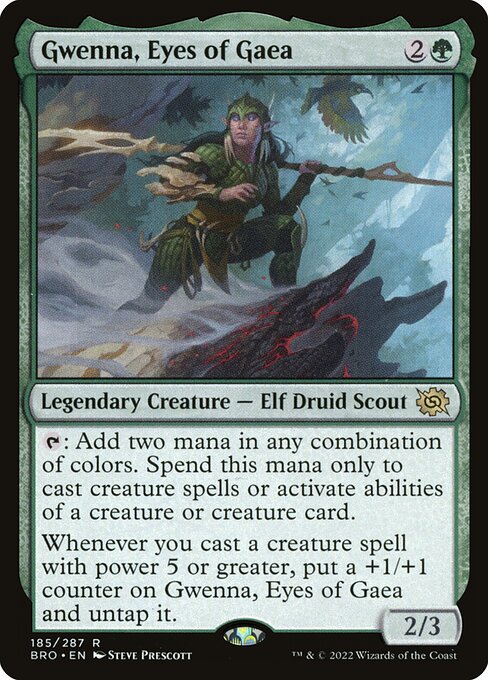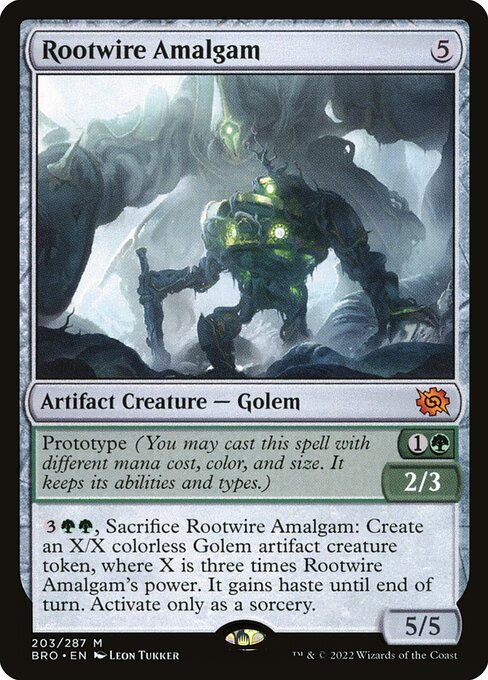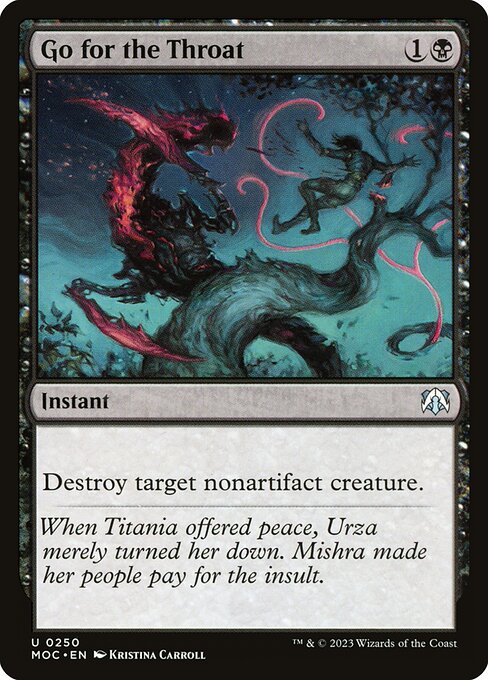Table of Contents
In the pursuit of making green playable in Standard, I came to realise that Fight Rigging is a legal card in the current Standard environment. With Cut Down and Abrade played left and right, we can try to take advantage of it by playing threats that are immune to those pieces of removal.
This is a Golgari Stompy deck at heart with the aim to keep playing creatures that outsize and outmuscle whatever the opponent is presenting. A lot of draws will involve us playing, say, normal Magic with a ton of threats and a removal spell here and there. However, we have a way to nut draw the opponent once Fight Rigging is involved. It’s a tool to go over the top in a fashion that’s difficult to stop. This dynamic comes in handy against the midrange decks of the format which you will find all over the top tables. As we still play a plethora of creatures, we won’t be too vulnerable to other creature strategies, as the vast majority of our spells will affect the battlefield and enable us to block.
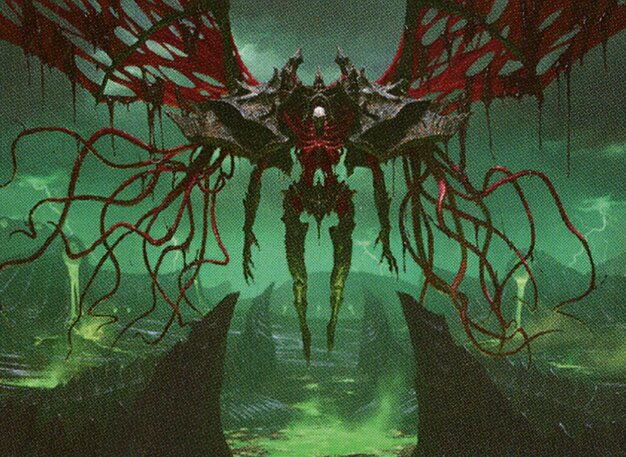
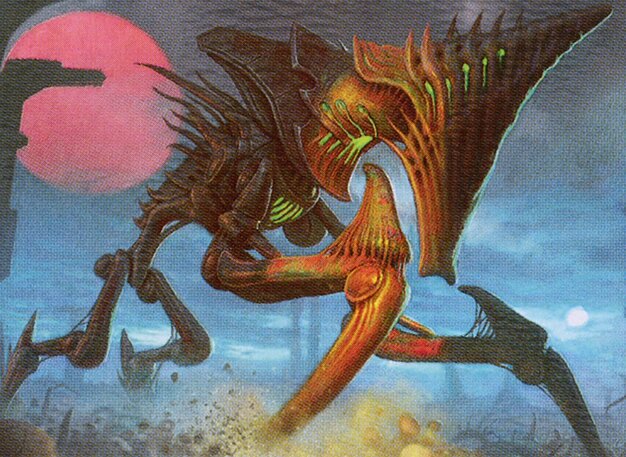

Planeswalkers (4)
Creatures (24)
Instants (4)
Enchantments (4)
Lands (24)
60 Cards
$290.32
Sideboard
15 Cards
$187.77
Deck Tech
Let us address the namesake enchantment first so that we know what we are building towards. Fight Rigging is an enchantment that comes down on turn three and allows you to exile one of the top five cards under it. Then, at the beginning of each combat on your turn, it will permanently buff a creature with a +1/+1 counter. Now for the twist – if after the buff its power is 7 or more, you can play the card you’ve exiled under it *for free*. Why is it good?
First, in this deck there are multiple powerful threats, which we will delve into later, that are super strong if played for 0 mana. The two biggest benefactors are Planeswalkers with phyrexian symbols and prototype creatures. The trick is that you can play prototype creatures for their cheap cost early in the game but if you cast them off Rigging you can play the stronger version of them. E.g. Phyrexian Fleshgorger can be cast as a 7/5 creature. On top of that, phyrexian cost is a way to cheat again, since you can play it for cheaper when you cast it normally, but treat it as a full-cost card when played off Rigging.
In addition, after you’ve played the card from beneath Rigging, you still get its ability every turn so your creatures will get buffed each combat for the rest of the game.
All in all, it’s a way to change the combat dynamics and overload the board with powerful threats that are, usually, played ahead of schedule.
The fastest way to turn on Fight Rigging is to deploy a creature with at least 6 power so that it immediately meets the condition when the +1/+1 counter is placed. One of such creatures is Shakedown Heavy that comes down as soon as turn three. On its own it’s a menacing creature – literally. 6 power with evasion is no joke and it dodges Abrade and Cut Down. Even without the namesake, it will dominate most boards. When you do draw Rigging though, it’s a nice cherry on top.
While the opponent technically could make you never connect with it due to the Heavy’s clause, you’d be drawing an additional card every turn. With so many resources you wouldn’t really complain about being unable to attack, especially as you’d still trigger Rigging once you deploy it.
Menace shines against pesky creatures that love chump blocking like Spirited Companion or Ambitious Farmhand.
Another 6-power creature that we have just got from Phyrexia: All Will Be One is Archfiend of the Dross. It also has evasion but in the form of flying – flying is much harder to interact with on the board compared to menace. There are not that many frequently played creatures in the format that block it, let alone block profitably. In most cases, three attacks are enough to close the game and come out with a win. If the opponent wants to chump their way out of trouble, it is technically doable, but Archfiend’s last ability will drain them out.
A four-mana flier with such stats and a beneficial trigger would certainly be very strong. However, it does have a downside. It enters with four oil counters and every upkeep you have to remove one. When the trigger tries to resolve, but there are no oil counters, you will actually lose the game on the spot. It might sound scary, but in practice, it would take five upkeeps for that to happen and I doubt any opponent is surviving that long with Archfiend on the battlefield. All in all, I wouldn’t worry too much about the clause.
Both Shakedown Heavy and Archfiend of the Dross make a formidable team of early beaters.
We play only one planeswalker, but it’s a strong one. Nissa, Ascended Animist is usually going to be cast for five mana, as a compleated walker with five loyalty counters on it. It can act as Naturalize on a stick, but what we really want is the plus one. It’s a token machine that allows you to not only go tall, like we normally do with the aforementioned creatures, but also wide. Diversifying angles of attack can cause real headaches for opponents who want to interact with us.
If the games do go long, playing it for the full cost of seven mana might come up but I wouldn’t expect that to happen too frequently.
The best case scenario for us is Nissa played off Fight Rigging, as it’d be played for free but it would be treated as a 7-mana walker. Hence, we pay no mana but get Nissa with seven counters on it. If we curve out Heavy/Archfiend into Rigging, we could see Nissa come down as soon as turn four and already start pumping out 8+ power threats.
While it’s good to cheat our top-end spells into play with Fight Rigging, we cannot rely fully on it. There will be hands where you don’t draw it and you’ll still want to play a functional game of Magic. Armored Scrapgorger allows you to ramp into Nissa or prototype creatures in a more fair way. On top of that, it gives you the ability to multispell e.g. on turn four, you’d have access to five mana, enabling sequences such as Shakedown Heavy and Go for the Throat.
Arguably the strongest curve would be turn two Scrapgorger into turn three Archfiend of the Dross which is very threatening.
In addition to its ramping capabilities, it’s a decent blocker in the early game that buys you time against aggressive strategies. Later in the game its power does not diminish substantially since it becomes a 3/3 creature that can start putting real pressure on the opponent or trade effectively in combat.
Another piece of ramp is Gwenna, Eyes of Gaea. It plays the same role as Scrapgorger with the main difference being that she produces two mana instead of one. It comes up particularly often when it comes to casting prototype creatures for their full cost. If you play her on turn three, on turn four you will have access to six mana which can also be spent on, say, Fight Rigging and Shakedown Heavy.
She also has a trigger which untaps and grows her when a creature with 5 or more power is cast. Thankfully, that includes all the prototypes, Archfiend, and Heavy, so there are 16 creatures that would trigger it. The untap part allows you to chain creatures, since you get to spend two mana again. On top of that, she gets bigger and at some point she becomes a threat herself.
The first prototype creature that I’ve been talking so much about. Rootwire Amalgam is, for all intents and purposes, a two-drop. It stabilises a bit with its 3 points of toughness against creatures like Bloodthirsty Adversary or Feldon, Ronom Excavator. We do want to deploy it early, as the deck has quite heavy top-end already and we don’t want to wait four turns until we start playing the game.
As its full cost is 5, it is quite easy to actually hardcast it. It’s a 5/5 that’s unkillable by Cut Down or Go for the Throat and blocks most stuff in the format, including Corpse Appraiser, Sheoldred, the Apocalypse, or crewed Reckoner Bankbuster.
Activating its ability could come up if you’re otherwise running out of gas. However, don’t rush it if you expect that the opponent might have Abrade. It’d be a huge blowout as you’d lose your creature and five mana in the process.
Another early creature that doubles up as a heavy hitter later in the game. Phyrexian Fleshgorger has a similar function to Amalgam in that it blocks threats in the first few turns, buying the time before the big threats hit the board. Lifelink is particularly good to swing races in your favor as you want to live to cast your bombs. You can also attack in, almost ensuring that it connects thanks to menace, as you’re still gaining life while being aggressive. Fleshgorger really benefits from the +1/+1 counters of Fight Rigging, as it will gain more and more life and the ward ability becomes harsher for the opponent.
When hardcast, a 7/5 creature with lifelink and menace will turn games around very fast. If you’re behind, it will ensure that you’re health points get boosted. If you’re ahead, it will close the game in 1-2 attacks.
It’s all in all a great creature, as it serves two important purposes: early blocking, late-game combat domination.
Interaction
In the main deck there isn’t much interaction, as we want to enact our proactive, linear, and creature-focused game plan. However, we do play a full play set of Go for the Throat.
Go for the Throat is our removal of choice, as it can largely kill anything that stands in our way. Some of the most important threats to be removed are Sheoldred, the Apocalypse, Serra Paragon, or Raffine, Scheming Seer.
We usually won’t need to cast it early as our creatures will outmuscle the opponent’s threats. While this should hold true later as well, having a removal spell enables us to push damage through or mess up opposing multi-blocking.
Best of One



Planeswalkers (4)
Creatures (24)
Instants (4)
Enchantments (4)
Lands (24)
60 Cards
$290.32
The version of Best of One is aligned with the main deck of the Best of Three version.
Budget
Unfortunately, there is no way to make the deck budget friendly. While the mana base could even be just basic lands in this two-colour shell, all the threats are rares or mythics. Changing them to uncommons would hurt the deck greatly.
Matchups and Sideboard Guide

Grixis Midrange
| IN | OUT |
|---|---|
| +3 Reckoner Bankbuster | -2 Go for the Throat |
| +2 Sheoldred, the Apocalypse | -4 Armored Scrapgorger |
| +3 Graveyard Trespasser | -2 Gwenna, Eyes of Gaea |
In this matchup, I want to increase the average card quality. I cut ramp as we don’t need to play ahead of curve. Knowing that we can outsize their threats, we just want to steadily make land drops and play spells. The worst case for us would be if we drew multiple mana dorks and basically did nothing.
You should absolutely expect to hard cast your prototypes, since the games might drag out. Same goes for full cost Nissa, Ascended Animist.
Mono White Midrange
Mono White spends more time adding to the board than interacting with us, so I keep in the ramp. I cut Rootwire Amalgam completely since it we don’t really need to block anything and a creature with 2 power won’t put any real pressure on them.
You should beware Farewell, but otherwise it should be okay.
Similarly to Grixis, the game will take a while so you might be hardcasting your top-end quite a bit.
Azorius Soldiers
| IN | OUT |
|---|---|
| +2 Parasitic Grasp | -3 Nissa, Ascended Animist |
| +4 Cut Down | -2 Fight Rigging |
| +3 Graveyard Trespasser | -4 Gwenna, Eyes of Gaea |
Due to the aggressive nature of Soldiers, we want all the removal in. We will largely play a midrange game with removal and creatures blocking. I cut expensive noncreature spells in order to avoid them clogging up the hand and to play around Thalia, Guardian of Thraben
You should assume a control role but be ready to turn to the corner at an opportune moment. After all, we have got a ton of threatening creatures that kill very fast.
Mono Red Aggro
| IN | OUT |
|---|---|
| +2 Parasitic Grasp | -4 Nissa, Ascended Animist |
| +4 Cut Down | -4 Gwenna, Eyes of Gaea |
| +4 Graveyard Trespasser | -3 Fight Rigging |
| +1 Sheoldred, the Apocalypse |
Another aggressive deck where we want to pivot into a more controlly role. What’s good for us is that they can never attack through a 6/6 creature. Our incidental life gain in Parasitic Grasp or Phyrexian Fleshgorger are going to shine here, essentially blanking their burn spells.
We are going to be much less all-in and way more Golgari Rock style, killing everything we see and finishing the game with a single threat smashing in.
Golgari Rigging Mirror
| IN | OUT |
|---|---|
| +4 Graveyard Trespasser | -4 Rootwire Amalgam |
Go for the Throat is what the game is going to be about, as the first person to successfully pump their creature and resolve Fight Rigging ability is probably going to win. However, if neither player actually goes off, it will become a chess-like game where you will play in combat a lot. Both players will have to carefully calculate attacks as they might die on the backswing.
Tips and Tricks

- Nissa, Ascended Animist tokens’ power and toughness are static and they don’t change over time like a */* Construct or Wrenn and Seven token would.
- Nissa, Ascended Animist‘s ultimate cares about Forests. Remember that Deathcap Glade, Boseiju, Who Endures, or Llanowar Wastes are *not* Forests while Ziatora's Proving Ground is.
- Against decks with Graveyard Trespasser, it’s good to hold up Armored Scrapgorger to exile whatever their Trespasser targets.
- You can block a creature with Armored Scrapgorger, and after the blocks have been declared, activate it so that it gets the third oil counter and gets the buff.
- If you include any proliferate cards in the deck, you can uptick the number of oil counters on Archfiend of the Dross so that its end-the-game trigger happens later.
- Prototypes have abilities whose effect is dependent upon the creature’s power, so keep in mind that Fight Rigging +1/+1 counters will affect those abilities.
- When you play prototypes for the cheaper cost, they will have colour identity (Phyrexian Fleshgorger would be black), but they are still artifacts. It means that despite not being colorless, they cannot be killed with Go for the Throat. They can, however, be destroyed with Abrade.








